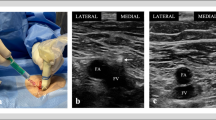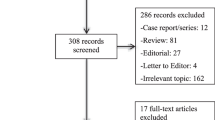Abstract
Aims
We evaluated the prognostic impact of a first episode of symptomatic atrial fibrillation under real life conditions.
Background
Most studies regarding the treatment and long-term outcome of patients with atrial fibrillation mainly refer to patients with recurrent episodes. In contrast, data on the prognostic implications of a first episode of atrial fibrillation are scarce.
Methods
Over a follow-up period of 5 years, we analyzed 1053 patients, initially scheduled for cardioversion of symptomatic atrial fibrillation, who were included into the prospective registry ANTIK (Ludwigshafener ANTIKoagulationsstudie).
Results
Of those, 618 patients (59%) were included with a first episode of symptomatic atrial fibrillation whereas 435 patients (41%) presented with recurrent episodes. As a consequence of referral for cardioversion of symptomatic atrial fibrillation, structural heart disease was newly diagnosed in a significantly higher proportion of patients with a first episode (27 vs 13%, OR 2.4, 95% CI 1.7–3.3) and patients with a first episode were more likely to have an EF≤40% (21 vs 15%, OR 1.5, 95% CI 1.1-2.2). After 5 years, the mortality rate for patients with a first episode was higher than for those with recurrent episodes (27 vs 16%, OR 2.0, 95% CI 1.4–2.7). In the multivariate analysis, a first episode also was independently associated with an increased longterm mortality (HR 1.4, 95% CI 1.02–1.98). In contrast to patients with recurrent episodes, a first episode was associated with a significantly higher mortality, when compared to an age-matched control group calculated from mortality tables.
Conclusion
The first episode of symptomatic atrial fibrillation intended for cardioversion serves as a marker for underlying cardiac diseases and is associated with impaired prognosis.
Similar content being viewed by others
References
Albers GW, Diener HC, Frison L, Grind M, Nevinson M, Partridge S, Halperin JL, Horrow J, Olsson SB, Petersen P, Vahanian A; SPORTIF Executive Steering Committee for the SPORTIF V Investigators (2005) Ximelagatran vs Warfarin for stroke prevention in patients with nonvalvular atrial fibrillation: a randomized trial (SPORTIF V). JAMA 293:690–698
The AFFIRM Investigators (2002) Baseline characteristics of patients with atrial fibrillation: the AFFIRM study. Am Heart J 143:991–1001
The AFFIRM Investigators (2004) Relationships between sinus rhythm, treatment, and survival in the Atrial Fibrillation Follow-Up Investigation of Rhythm Management (AFFIRM) Study. Circulation 109:1509–1513
Benjamin EJ, Levy D, Vaziri SM, D’Agostino RB, Belanger AJ, Wolf PA (1994) Independent risk factors for atrial fibrillation in a populationbased cohort: the framingham heart study. JAMA 271:840–844
Benjamin EJ, Wolf PA, D’Agostino RB, Silbershatz H, Kannel WB, Levy D (1998) Impact of atrial fibrillation on the risk of death. Circulation 98:946–952
Bernhardt P, Schmidt H, Sommer T, Lüderitz B, Omran H (2006) Atrial fibrillation – patients at high risk for cerebral thromboembolism. Clin Res Cardiol 95:148–153
Brugada P (2006) What evidence do we have to replace in-hospital implantable cardioverter defibrillator follow-up? Clin Res Cardiol 95 (Suppl 3):iii3–9
Conradi G, Deetjen A, Möllmann S, Hamm CW, Dill T (2006) Symptomatic atrial fibrillation as the first symptom of a giant left atrial appendage aneurysm. Clin Res Cardiol 95:614–616
Dries DL, Exner DV, Gersh BJ, Domanski MJ, Waclawiw MA, Stevenson LW (1998) Atrial fibrillation is associated with an increased risk for mortality and heart failure progression in patients with asymptomatic and symptomatic left ventricular dysfunction: a retrospective analysis of the SOLVD trials. J Am Coll Cardiol 32:965–703
Finsterer J, Stöllberger C, Krugluger W (2007) Positive troponin-T in noncompaction is associated with neuromuscular disorders and poor outcome. Clin Res Cardiol 96:109–113
Flaker GC, Belew K, Beckman K, Vidaillet H, Kron J, Safford R, Mickel M, Barrell P (2005) AFFIRM Investigators. Asymptomatic atrial fibrillation: demographic features and prognostic information from the Atrial Fibrillation Follow-up Investigation on Rhythm Management (AFFIRM) study. Am Heart J 149:657–663
FusterV, Rydén LE, Cannorn DS, Crijns HJ, Curtis AB et al (2006) ACC/AHA/ ESC guidelines for the management of patients with atrial fibrillation. A report of the American college of cardiology/ American heart association task force on practice guidelines and the European society of cardiology committee for practice guidelines (writing committee to revise the 2001 guidelines for the management of patients with atrial fibrillation). J Am Coll Cardiol 48:e149–246
Fuster V, Rydén LE, Gibbons RJ, Antman EM, Klein WW et al (2001) ACC/AHA/ESC guidelines for the management of patients with atrial fibrillation: executive summary. A report of the American College of Cardiology/ American heart association taskforce on practice guidelines and the European society of cardiology committee for practice guidelines and policy conferences (committee to develop guidelines for the management of patients with atrial fibrillation) developed in collaboration with the North American society for pacing and electrophysiology. J Am Coll Cardiol 38:1266i–1266ixx
Gage BF, Waterman AD, Shannon W, Boechler M, Rich MW, Radford MJ (2001) Validation of clinical classification schemes for predicting stroke: results from the national registry of atrial fibrillation. JAMA 285:2864–2870
Hylek EM, Go AS, Chang Y, Jensvold NG, Henault LE, Selby JV, Singer DE (2003) Effect of intensity of oral anticoagulation on stroke severity and mortality in atrial fibrillation. N Engl J Med 349:1019–1026
Jouven X, Desnos M, Guerot C, Ducimetiere P (1999) Idiopathic atrial fibrillation as a risk factor for mortality. The Paris Prospective Study I. Eur Heart J 20:896–899
Kettering K, Greil GF, Busch M, Miller S, Sieverding L, Schreieck J (2006) Catheter ablation of atrial fibrillation: ongoing atrial fibrillation inside a single pulmonary vein after successful electrical disconnection and restoration of sinus rhythm in both atria. Clin Res Cardiol 95:663–667
Kleemann T, Becker T, Dönges K, Vater M, Gut B, Schneider S, Senges J, Seidl K (2007) The prognostic impact of successful cardioversion of atrial fibrillation in patients with organic heart disease. Clin Res Cardiol 96:103–108
Krahn AD, Manfreda J, Tate RB, Mathewson FA, Cuddy TE (1995) The natural history of atrial fibrillation: incidence, risk factors, and prognosis in the mannitoba follow-up study. Am J Med 98:476–484
Langer C, Piper C, Vogt J, Heintze J, Butz T, Lindner O, Burchert W, Kersting C, Horstkotte D (2007) Atrial fibrillation in carcinoid heart disease – the role of serotonin. A review of the literature. Clin Res Cardiol 96:114– 118
Levy S, Maarek M, Coumel P, Guize L, Lekieffre J, Medvedowsky JL, Sebaoun A for the College of French Cardiologists (1999) Characterization of different subsets of atrial fibrillation in general practice in France. The ALFA Study. Circulation 99:3028–3035
Lin HJ, Wolf PA, Kelly-Hayes M, Beiser AS, Kase CS, Benjamin EJ, D’Agostino RB (1996) Stroke severity in atrial fibrillation: the framingham heart study. Stroke 27:1760–1764
Lip GYH (1999) Atrial fibrillation and mortality. Eur Heart J 20:1525–1527
Obergassel L, Lawrenz T, Gietzen FH, Lieder F, Leuner C, Kuhn H, Stellbrink C (2006) Effect of transcoronary ablation of septal hypertrophy on clinical outcome in hypertrophic obstructive cardiomyopathy associated with atrial fibrillation. Clin Res Cardiol 95:254–260
Ostranderld JR, Brandt RL, Kjelsberg MO, Epstein FH (1965) Electrocardiographic findings among the adult population of a total natural community, Tecumseh, Michigan. Circulation 31:888–898
Prystowsky EN, Benson DW Jr, Fuster V, Hart RG, Kay GN, Myerburg RJ, Naccarelli GV, Wyse DG (1996) Management of patients with atrial fibrillation. A statement for healthcare professionals. From the subcommittee on electrocardiography and electrophysiology. American Heart Association. Circulation 93:1262–1277
Psaty BM, Manolio TA, Kuller LH, Kronmal RA, Cushman M, Fried LP, White R, Furberg CD, Rautaharju PM (1997) Incidence and risk factors for atrial fibrillation in older adults. Circulation 96:2455–2461
Reibis RK, Dovifat C, Dissmann R, Ehrlich B, Schulz S, Stolze K, Wegscheider K, Völler H (2006) Implementation of evidence-based therapy in patients with systolic heart failure from 1998–2000. Clin Res Cardiol 95:154–161
Ricci RP, Russo M, Santini M (2006) Management of atrial fibrillation – what are the possibilities of early detection with home monitoring? Clin Res Cardiol 95(Suppl 3):iii10–16
Steinberg JS, Sadaniantz A, Kron J, Krahn A, Denny DM, Daubert J, Campbell WB, Havranek E, Murray K, Olshansky B, O’Neill G, Sami M, Schmidt S, Storm R, Zabalgoitia M, Miller J, Chandler M, Nasco EM, Greene HL and the AFFIRM Investigators (2004) Analysis of cause-specific mortality in the Atrial Fibrillation Follow-Up Investigation of Rhythm Management (AFFIRM) Study. Circulation 109:1973–1980
Stewart S, Hart CL, Hole DJ, McMurray JJ (2002) A population-based study of the long-term risks associated with atrial fibrillation: 20-year follow-up of the Renfrew/Paisley study. Am J Med 113:359–364
Strohmer B, Schernthaner C, Pichler M (2006) Simultaneous angiographic imaging of ipsilateral pulmonary veins for catheter ablation of atrial fibrillation. Clin Res Cardiol 95:591–599
Van Gelder IC, Hagens VE, Bosker HA, Kingma JH, Kamp O, Kingma T, Said SA, Darmanata JI, Timmermans AJ, Tijssen JG, Crijns HJ for the RACE Study group (2002) A comparison of rate control and rhythm control in patients with recurrent persistent atrial fibrillation (RACE). N Engl J Med 347:1834–1840
Vaughan-Williams EM (1984) A classification of antiarrhythmic actions reassessed after a decade of new drugs. J Clin Pharmacol 24:129–147
Vidaillet H, Granada JF, Chyou PH, Maassen K, Ortiz M, Pulido JN, Sharma P, Smith PN, Hayes J (2002) A population-based study of mortality among patients with atrial fibrillation or flutter. Am J Med 113:365–370
Wang TJ, Larson MG, Levy D, Ramachandran SV, Leip EP, Wolf PA, D’Agostino RB, Murabito JM, Kannel WB, Benjamin EJ (2003) Temporal relations of atrial fibrillation and congestive heart failure and their joint influence on mortality. The Framingham Heart Study. Circulation 107:2920–2925
Wyse DJ, Waldo AL, DiMarco JP, Domanski MJ, Rosenebrg Y, Schron EB, Kellen JC, Greene HL, Mickel MC, Dalquist JE Corley SD for The AFFIRM Investigators (2002) A comparison of rate control and rhythm control in patients with atrial fibrillation. N Engl J Med 347:1825–1833
Statistisches Bundesamt (2006) Periodensterbetafeln für Deutschland: Allgemeine und abgekürzte Sterbetafeln von 1871/1881–2002/2004, Wiesbaden. http://www-ec.destatis.de/csp/ shop/sfg/vollanzeige.csp?ID=1017978
Author information
Authors and Affiliations
Corresponding author
Rights and permissions
About this article
Cite this article
Becker, T., Kleemann, T., Strauss, M. et al. Long-term prognosis after cardioversion of the first episode of symptomatic atrial fibrillation: a condition believed to be benign revised. Clin Res Cardiol 97, 74–82 (2008). https://doi.org/10.1007/s00392-007-0584-y
Received:
Accepted:
Published:
Issue Date:
DOI: https://doi.org/10.1007/s00392-007-0584-y




